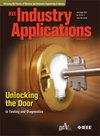采用增材制造的热交换器对电机绕组进行极高电流密度的冷却
IF 4.5
2区 工程技术
Q2 ENGINEERING, ELECTRICAL & ELECTRONIC
引用次数: 0
摘要
有效的热管理是至关重要的电机,其中绕组是主要的热源。目前采用的冷却方法,如定子套和油喷雾冷却,需要热量通过定子轭或绕组的轴向长度传播,导致效率低下。本研究介绍了一种新颖的槽内冷却设计,该设计直接将3d打印热交换器与绕组集成在一起,解决了高功率密度机器中高效散热的挑战。该设计的特点是扁平的铜线绕组连接到导热、电绝缘的聚合物热交换器上,采用增材制造技术生产。通过将冷却剂移近绕组,提出的设计提高了载流能力并降低了工作温度。这种配置减小了定子槽的尺寸,同时显着增加了绕组和槽中的电流密度,分别是传统液冷机器的2倍和3倍。结果表明,这些集成的热交换器不仅提高了电流密度,而且减小了机器槽尺寸,推进了适用于各种工业应用的高性能电机的设计。本文章由计算机程序翻译,如有差异,请以英文原文为准。
Cooling of Motor Windings Using Additively Manufactured Heat Exchangers for Extremely High Current Density
Effective thermal management is crucial for electric machines, where windings are the primary heat source. Currently employed cooling methods, like stator jacket and oil spray cooling, require heat to travel through the stator yoke or the axial length of the windings, leading to inefficiencies. This study introduces a novel in-slot cooling design that directly integrates a 3D-printed heat exchanger with the winding, addressing the challenge of efficient heat dissipation in high-power density machines. The design features flat copper wire windings bonded to a thermally conductive, electrically insulating polymer heat exchanger, produced using additive manufacturing. By moving the coolant closer to the windings, the proposed design enhances the current-carrying capacity and lowers operating temperatures. This configuration reduces the stator slot size while significantly increasing current density in the windings and slots by factors of 2x and 3x, respectively, compared to conventional liquid-cooled machines. The results demonstrate that these integrated heat exchangers not only improve current density but also reduce machine slot size, advancing the design of high-performance electric machines suitable for diverse industrial applications.
求助全文
通过发布文献求助,成功后即可免费获取论文全文。
去求助
来源期刊

IEEE Transactions on Industry Applications
工程技术-工程:电子与电气
CiteScore
9.90
自引率
9.10%
发文量
747
审稿时长
3.3 months
期刊介绍:
The scope of the IEEE Transactions on Industry Applications includes all scope items of the IEEE Industry Applications Society, that is, the advancement of the theory and practice of electrical and electronic engineering in the development, design, manufacture, and application of electrical systems, apparatus, devices, and controls to the processes and equipment of industry and commerce; the promotion of safe, reliable, and economic installations; industry leadership in energy conservation and environmental, health, and safety issues; the creation of voluntary engineering standards and recommended practices; and the professional development of its membership.
 求助内容:
求助内容: 应助结果提醒方式:
应助结果提醒方式:


